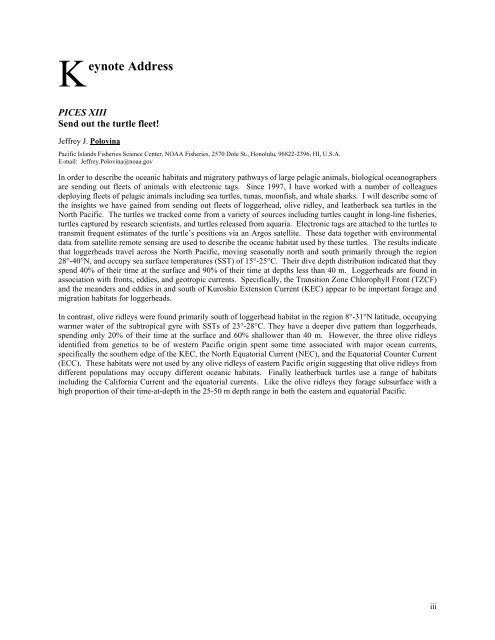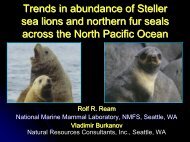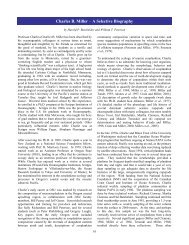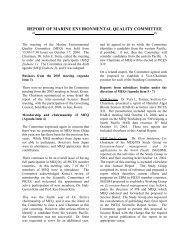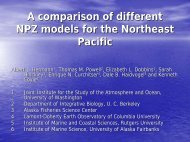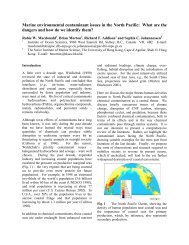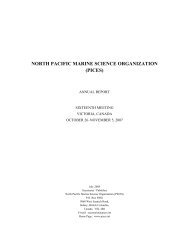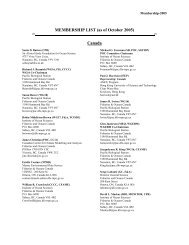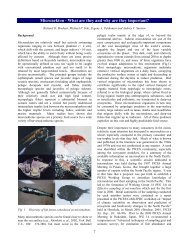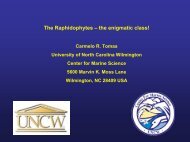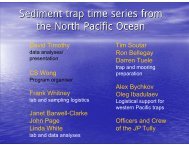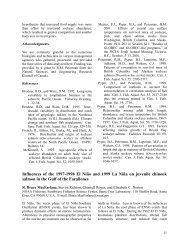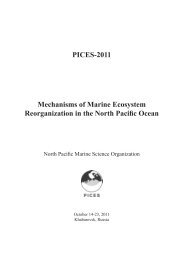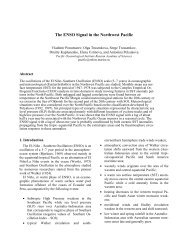- Page 5: PICES XIIIAbstracts
- Page 9 and 10: PICES XIII S1-2185 OralTemporal var
- Page 11 and 12: PICES XIII S1-1773 PosterResults of
- Page 13 and 14: the west and east of the Emperor Se
- Page 15 and 16: Nino, intrinsic variability of the
- Page 17: PICES XIII S1-1833 OralPossible eco
- Page 20 and 21: 11:50-12:10 Jennifer L. Nielsen and
- Page 23 and 24: PICES XIII S2-1934 OralLarval stage
- Page 25 and 26: adaptations to habitat change, mixe
- Page 27 and 28: In the 50 years since, the debate h
- Page 29 and 30: PICES XIII S2-2043 InvitedEvaluatin
- Page 31 and 32: salmon or $310 million (1997-2000).
- Page 33 and 34: PICES XIII S2-2148 OralPhase relati
- Page 35: PICES XIII S2-1802 OralChanges of n
- Page 38 and 39: PostersPei-Kai Hsu, Wen-Tseng Lo an
- Page 40 and 41: population sizes. Populations of ge
- Page 42 and 43: PICES XIII S3-2127 PosterNew findin
- Page 44 and 45: PICES XIII S3-1899 OralClimate effe
- Page 46 and 47: PICES XIII S3-1838 PosterAbundance
- Page 48 and 49: 11:00-11:20 Rogelio Gonzalez-Armas,
- Page 51 and 52: PICES XIII S4-2020 InvitedTagging o
- Page 53 and 54:
prey that determined the location a
- Page 55 and 56:
corresponded to the annual growth r
- Page 57 and 58:
PICES XIII S4-1977 InvitedStomach c
- Page 59 and 60:
PICES XIII S4-1815 PosterTransport
- Page 61 and 62:
PICES XIII S4-2060 PosterWing loadi
- Page 63:
looms covered more than 350,000 km
- Page 66 and 67:
12:10-13:50 Lunch13:50-14:10 Jennif
- Page 68 and 69:
PICES XIII S5-2094 OralBallast wate
- Page 70 and 71:
PICES XIII S5-1969 InvitedBallast w
- Page 72 and 73:
Mediterranean and semi-tropical env
- Page 75:
S6MEQ Topic SessionMarine Protected
- Page 78 and 79:
PICES XIII S6-1938 OralThe utility
- Page 80 and 81:
The paper outlines the types and sc
- Page 82 and 83:
11:50-13:00 Lunch13:00-13:30 Donald
- Page 85 and 86:
PICES XIII S7-1819 OralCharacterisi
- Page 87 and 88:
Levitus Atlas (on CD-R), and Japane
- Page 89 and 90:
PICES XIII S7-2029 InvitedData assi
- Page 91 and 92:
project is expected to develop new
- Page 93 and 94:
PICES XIII S7-2007 PosterUpper ocea
- Page 95 and 96:
anomalies in the Kamchatka Current
- Page 97 and 98:
PICES XIII S7-2044 OralComparison o
- Page 99:
PICES XIII S7-1832 OralPOST: The de
- Page 102 and 103:
16:10-16:30 Hernan E. Garcia, Tim B
- Page 105 and 106:
PICES XIII S8-2015 OralIncreases in
- Page 107 and 108:
ice edge, which is related to chang
- Page 109 and 110:
as part of the WOCE/JGOFS Global CO
- Page 111 and 112:
PICES XIII S8-1915 PosterDecadal tr
- Page 113 and 114:
PICES XIII S8-2102 OralAge and AOU
- Page 115 and 116:
7Universitat Kiel, Institut fuer Me
- Page 117:
PICES XIII S8-2174 OralInitial resu
- Page 120 and 121:
16:50-17:10 Enrique Curchitser, Dal
- Page 122 and 123:
Albert J. Hermann, Enrique N. Curch
- Page 124 and 125:
PICES XIII S9-1936 PosterComparing
- Page 126 and 127:
PICES XIII S9-2084 PosterOn the ori
- Page 128 and 129:
PICES XIII S9-1850 OralThe Optimal
- Page 130 and 131:
PICES XIII S9-1804 PosterReorganiza
- Page 132 and 133:
effects, including the penetration
- Page 134 and 135:
year. Contrasts in the biological r
- Page 136 and 137:
PICES XIII S9-1949 PosterThe effect
- Page 138 and 139:
PICES XIII S9-2142 PosterDecadal va
- Page 140 and 141:
PICES XIII S9-2204 OralGLOBEC Canad
- Page 142 and 143:
PICES XIII S9-1842 OralRussia in sc
- Page 144 and 145:
• No clear distributional relatio
- Page 147 and 148:
S10CCCC/MODEL Topic SessionModeling
- Page 149 and 150:
PICES XIII S10-1960 OralInterdecada
- Page 151 and 152:
PICES XIII S10-2120 OralA study for
- Page 153 and 154:
phytoplankton and two size-classes
- Page 155:
S11TCODE E-Poster SessionData visua
- Page 158 and 159:
PICES XIII S11-1849 E-posterThe tec
- Page 160 and 161:
PICES XIII S11-1788 E-posterAtlas o
- Page 163 and 164:
BIOPaper SessionSession Convenor: V
- Page 165 and 166:
PICES XIII BIO_P-1835 OralUse of ot
- Page 167 and 168:
were collected from 28 stations by
- Page 169 and 170:
population of P. sinica predominati
- Page 171 and 172:
summertime phenomenon in the offsho
- Page 173 and 174:
FISPaper SessionSession Convenor: Y
- Page 175:
Sergey V. Loboda and Pavel V. Vorob
- Page 178 and 179:
seasonally in relation to body cond
- Page 180 and 181:
V.N. Zyryanov (2003) theoretically
- Page 182 and 183:
PICES XIII FIS_P-2152 PosterStatus
- Page 184 and 185:
PICES XIII FIS_P-1937 OralPredictab
- Page 186 and 187:
PICES XIII FIS_P-1853 PosterThe dis
- Page 188 and 189:
Pollock larvae predominate the icht
- Page 190 and 191:
PICES XIII FIS_P-1959 PosterVideo a
- Page 192 and 193:
PICES XIII FIS_P-1924 OralAnalysis
- Page 194 and 195:
PICES XIII FIS_P-2051 PosterCurrent
- Page 196 and 197:
Toyomitsu Horii and Hiromu Zenitani
- Page 199 and 200:
PICES XIII GP-2184 PosterLipofuscin
- Page 201 and 202:
PICES XIII GP-1903 PosterBeyond bio
- Page 203 and 204:
PICES XIII GP-2161 PosterThe effect
- Page 205 and 206:
PICES XIII GP-2169 PosterThe season
- Page 207 and 208:
PICES XIII GP-1862 PosterSpatial co
- Page 209 and 210:
PICES XIII GP-1774 PosterThe status
- Page 211 and 212:
PICES XIII GP-1848 PosterVariation
- Page 213 and 214:
determines the interannual variabil
- Page 215 and 216:
Ulva lactuca) were collected every
- Page 217 and 218:
Kodolov, Gavrilov, 1981). Similarit
- Page 219:
PICES XIII GP-2119 PosterVertical d
- Page 223 and 224:
W2CCCC/REX WorkshopThe seasonal cyc
- Page 225 and 226:
PICES XIII W2-2074 OralThe seasonal
- Page 227 and 228:
PICES XIII W2-1954 PosterIn situ eg
- Page 229 and 230:
PICES XIII W2-1816 OralSeasonal cha
- Page 231:
PICES XIII W2-1866 OralYear-to-year
- Page 234 and 235:
13:30-14:10 Kosei Komatsu (Invited)
- Page 236 and 237:
western part of Jejudo, and the eas
- Page 238 and 239:
PICES XIII W3-2182 OralA review of
- Page 240 and 241:
14:00-14:15 Franz J. Mueter and Ber
- Page 243 and 244:
PICES XIII W4-2099 OralConsideratio
- Page 245 and 246:
PICES XIII W4-2167 InvitedImplicati
- Page 247 and 248:
PICES XIII W4-1811 OralIntegrated a
- Page 249 and 250:
PICES XIII W4-1925 InvitedTropical
- Page 251 and 252:
PICES XIII W4-1996 OralRelationship
- Page 253 and 254:
W5-HABMEQ Workshop and HAB MeetingD
- Page 255:
13:30-14:00 Michelle C. Tomlinson,
- Page 258 and 259:
PICES XIII W5-2179 OralThe joint IO
- Page 260 and 261:
PICES XIII W5-2195 OralTesting the
- Page 262 and 263:
understand where the bloom inoculum
- Page 264 and 265:
PICES XIII HAB-1825 OralThe occurre
- Page 267 and 268:
PICES XIII W6-2125 OralFood of toot
- Page 269:
PICES XIII W6-2149 OralSpatio-tempo
- Page 272 and 273:
Boo, Sung Min S5-2139 p.67Borisenko
- Page 274 and 275:
Glubokov, Alexander I. S1-1773 p.5G
- Page 276 and 277:
Kato, Hidehiro S4-1983 p.46Katugin,
- Page 278 and 279:
Man'ko, Alexander N. GP-1945 p.206M
- Page 280 and 281:
Peña, Angelica HAB-2200 p.256S7-21
- Page 282 and 283:
Sugisaki, Hiroya S9-1944 p.121S9-19
- Page 284 and 285:
Yamamoto, Jun S2-1939 p.26Yamanaka,


